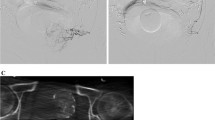Abstract
The gold standard treatment for benign prostate hyperplasia (BPH) is transurethral resection of the prostate (TURP) or open prostatectomy (OP). Recently, there has been increased interest and research in less invasive alternative treatments with less morbidity including prostate artery embolization (PAE). Several studies have shown PAE to be an effective alternative to TURP to treat lower urinary tract symptoms (LUTS) associated with BPH with decreased morbidity. Specifically, PAE has been advantageous in selected patient populations such as those with prostates too large for TURP or unsuitable surgical candidates, showing a promising potential for the future care of patients with BPH. Further studies are being done to demonstrate the clinical applications and advantages of this therapy in reduction of LUTS.

Similar content being viewed by others
References
Papers of particular interest, published recently, have been highlighted as: • Of importance •• Of major importance
Wei JT, Calhoun E, Jacobsen SJ. Urologic diseases in America project: benign prostatic hyperplasia. J Urol. 2005;173(4):1256–61.
American Urological Association guideline—management of benign prostatic hyperplasia (BPH).
Carnevale FC, Moreira AM, Antunes AA. The “PErFecTED technique”: proximal embolization first, then embolize distal for benign prostatic hyperplasia. Cardiovasc Intervent Radiol. 2014;37(6):1602–5.
McWilliams JP et al. Society of Interventional Radiology position statement: prostate artery embolization for treatment of benign disease of the prostate. J Vasc Interv Radiol. 2014;25(9):1349–51.
Thomas AW et al. The natural history of lower urinary tract dysfunction in men: minimum 10-year urodynamic follow-up of untreated detrusor underactivity. BJU Int. 2005;96(9):1295–300.
Aoun F, Marcelis Q, Roumeguere T. Minimally invasive devices for treating lower urinary tract symptoms in benign prostate hyperplasia: technology update. Res Rep Urol. 2015;7:125–36.
Sun F, et al. Prostatic Artery Embolization (PAE) for symptomatic benign prostatic hyperplasia (BPH): Part 2. Insights into the technical rationale. Cardiovasc Interv Radiol, 2015.
DeMeritt JS et al. Relief of Benign Prostatic Hyperplasia-related Bladder Outlet Obstruction after Transarterial Polyvinyl Alcohol Prostate Embolization. J Vasc Interv Radiol. 2000;11(6):767–70.
Jeon GS et al. The effect of transarterial prostate embolization in hormone-induced benign prostatic hyperplasia in dogs: a pilot study. J Vasc Interv Radiol. 2009;20(3):384–90.
Carnevale FC et al. Prostatic artery embolization as a primary treatment for benign prostatic hyperplasia: preliminary results in two patients. Cardiovasc Intervent Radiol. 2010;33(2):355–61.
Carnevale FC, Antunes AA. Prostatic artery embolization for enlarged prostates due to benign prostatic hyperplasia. How I do it. Cardiovasc Intervent Radiol. 2013;36(6):1452–63. This study provides extensive technical detail for PAE based on this influential group involved in pioneering PAE as well as vascular anatomy for the prostate. The study focuses on the significance of PAE for a more specific population of patients that are not eligible for TURP, and therefore can benefit from the decreased comorbidities of an interventional procedure compared to open surgery.
Bilhim T et al. Middle rectal artery: myth or reality? Retrospective study with CT angiography and digital subtraction angiography. Surg Radiol Anat. 2013;35(6):517–22.
Pisco JM et al. Prostatic arterial embolization to treat benign prostatic hyperplasia. J Vasc Interv Radiol. 2011;22(1):11–9. quiz 20.
Pisco JM et al. Embolisation of prostatic arteries as treatment of moderate to severe lower urinary symptoms (LUTS) secondary to benign hyperplasia: results of short- and mid-term follow-up. Eur Radiol. 2013;23(9):2561–72.
Isaacson AJ, Fischman AM, Burke CT. Technical feasibility of prostatic artery embolization from a transradial approach. AJR Am J Roentgenol. 2016;206(2):442–4.
Carnevale FC et al. Midterm follow-up after prostate embolization in two patients with benign prostatic hyperplasia. Cardiovasc Intervent Radiol. 2011;34(6):1330–3.
Pisco J et al. Prostatic arterial embolization for benign prostatic hyperplasia: short- and intermediate-term results. Radiology. 2013;266(3):668–77.
Bagla S et al. Early results from a United States trial of prostatic artery embolization in the treatment of benign prostatic hyperplasia. J Vasc Interv Radiol. 2014;25(1):47–52. This study provides further technical information related to PAE and data delineating the results for PAE. The study also focuses on benefits and advantages of using cone beam CT.
Li Q et al. Prostatic arterial embolization with small sized particles for the treatment of lower urinary tract symptoms due to large benign prostatic hyperplasia: preliminary results. Chin Med J. 2015;128(15):2072–7.
Bilhim T et al. Does polyvinyl alcohol particle size change the outcome of prostatic arterial embolization for benign prostatic hyperplasia? Results from a single-center randomized prospective study. J Vasc Interv Radiol. 2013;24(11):1595–602 e1.
Bilhim T et al. Prostatic arterial supply: anatomic and imaging findings relevant for selective arterial embolization. J Vasc Interv Radiol. 2012;23(11):1403–15.
Bagla S et al. Utility of cone-beam CT imaging in prostatic artery embolization. J Vasc Interv Radiol. 2013;24(11):1603–7.
Russo GI et al. Prostatic arterial embolization vs open prostatectomy: a 1-year matched-pair analysis of functional outcomes and morbidities. Urology. 2015;86(2):343–8.
de Assis AM et al. Prostatic artery embolization for treatment of benign prostatic hyperplasia in patients with prostates >90 g: a prospective single-center study. J Vasc Interv Radiol. 2015;26(1):87–93.
Gao Y et al. Benign prostatic hyperplasia: prostatic arterial embolization versus transurethral resection of the prostate—a prospective, randomized, and controlled clinical trial. Radiology. 2014;270(3):920–8.
Wang MQ et al. Prostatic arterial embolization for the treatment of lower urinary tract symptoms due to large (>80 mL) benign prostatic hyperplasia: results of midterm follow-up from Chinese population. BMC Urol. 2015;15:33.
Author information
Authors and Affiliations
Corresponding author
Ethics declarations
Conflict of Interest
Amir Noor declares no potential conflicts of interest.
Aaron Fischman reports grants from Merit Medical and personal fees from Terumo Interventional Systems and Surefire Medical.
Human and Animal Rights and Informed Consent
This article does not contain any studies with human or animal subjects performed by any of the authors.
Additional information
This article is part of the Topical Collection on New Imaging Techniques
Rights and permissions
About this article
Cite this article
Noor, A., Fischman, A.M. Prostate Artery Embolization as a New Treatment for Benign Prostate Hyperplasia: Contemporary Status in 2016. Curr Urol Rep 17, 51 (2016). https://doi.org/10.1007/s11934-016-0608-0
Published:
DOI: https://doi.org/10.1007/s11934-016-0608-0




